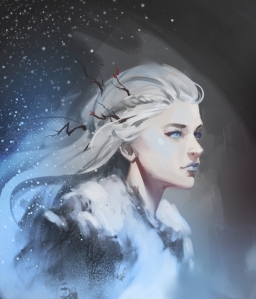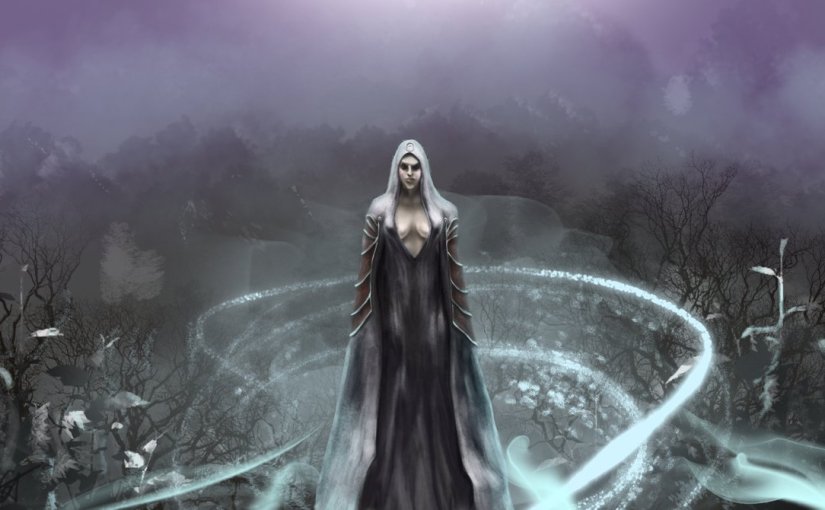 Marzanna (in Polish), Марена (in Russian), Morė (in Lithuanian), Morana (in Czech, Bulgarian, Slovene, Serbian, Bosnian, and Croatian), or Morena (in Slovak and Macedonian), Maslenitsa (in Russia) and also Mara (in Belarusian and Ukrainian), Maržena, Moréna, Mora or Marmora is a Baltic and Slavic goddessassociated with seasonal rites based on the idea of death and rebirth of nature. She is an ancient goddess associated with winter’s death and rebirth and dreams. In Slavic rites the death of the Goddess Marzanna at the end winter, becomes the rebirth of Spring of the Goddess Kostroma (Russian), Lada, Vesna representing the coming of Spring.
Marzanna (in Polish), Марена (in Russian), Morė (in Lithuanian), Morana (in Czech, Bulgarian, Slovene, Serbian, Bosnian, and Croatian), or Morena (in Slovak and Macedonian), Maslenitsa (in Russia) and also Mara (in Belarusian and Ukrainian), Maržena, Moréna, Mora or Marmora is a Baltic and Slavic goddessassociated with seasonal rites based on the idea of death and rebirth of nature. She is an ancient goddess associated with winter’s death and rebirth and dreams. In Slavic rites the death of the Goddess Marzanna at the end winter, becomes the rebirth of Spring of the Goddess Kostroma (Russian), Lada, Vesna representing the coming of Spring.
Some medieval Christian sources such as the Czech 9th century Mater Verborumcompare her to the Greek goddess Hecate, associating her with sorcery. 15th century Polish chronicler Jan Długosz likened her in his Annales to Ceres, the Roman goddess of agriculture (together with another Slavic goddess Dziewanna).
In modern times the rituals associated with Marzanna have lost their sacred character and are a pastime – an occasion to have fun and celebrate the beginning of spring. The tradition is usually celebrated around the spring equinox (March 21)[citation needed]. Usually schoolchildren and young people participate in the celebrations alongside local folklore groups and other residents. A procession consisting of men, women and children carries handmade Marzanna (and often also Marzaniok dolls, the male counterpart to Marzanna) to the nearest river, lake or pond. The participants sing traditional songs and throw effigies of Marzanna into the water. Sometimes the effigies are first set on fire, or their clothes are torn. On the journey back to the village the focus falls on the copses, adorned with ribbons and blown egg shells. The procession, still singing, returns to the village. In some locations (e.g. in Brynica – a district of Miasteczko Śląskie), the beginning of spring is then celebrated with a feast.
Names and etymology
Marzanna’s name most likely comes from the Proto-Indo-European root *mar-, *mor-, signifying death. The Slovak form of the theonym – Ma(r)muriena – suggests that the goddess may have originally been connected to the Roman god of war Mars (known under a variety of names, including Marmor, Mamers and Mamurius Veturius).[2] The connection to Mars is supported by, among others, Vyacheslav Ivanov and Vladimir Toporov, who underline that he was originally an agricultural deity.
Other theories claim her name is derived from the same Indo-European root as Latin mors ‘death’ and Russian mor ‘pestilence’. Some authors also likened her to mare, an evil spirit in Germanic and Slavic folklore, associated with nightmares and sleep paralysis. In Belarusian, Polish, Ukrainian and in some Russian dialects the word ‘mara’ means ‘phantom’, ‘vision’, ‘hallucination’.[4]
Similar to burning witches in some European countries or Holika Dahan in India, in terms of the season when its celebrated – at the end of winter, start of spring – and the evil character involved.
Significance
Today Marzanna is often perceived as a personification of winter and the symbolic drowning ends this season and returns life. In this interpretation, the copse is used to welcome spring and to affirm the re-awakening of nature. However, modern interpretations simplify the ritual: one example is merging two originally separate rituals and changing the time of the year at which they were celebrated. Moreover, even medieval chroniclers suggested that the custom had already evolved into a light-hearted, fun event and its original meaning had been almost forgotten.
Researchers emphasise that Marzanna functioned not merely as a symbol of winter, but also as a Slavic goddess. Marzanna’s later association with death (in some regions Marzanna is called Death Crone) trivialized the importance of the goddess, who was the lady of not only death, but also life, and commanded the natural world.
Drowning Marzanna in water (an element of high importance in season-related folk celebrations) is understood as the goddess’ symbolic descent into the underworld, to be reborn with next winter.[12] Some researchers underline the sacrificial character of this ritual and suggest that Marzanna is sacrificed in order to appease Winter. The authors of Wyrzeczysko propose that Marzanna is sacrificed to the demons of water, whose favour was necessary to ensure a plentiful harvest in the coming year.[13]
Celebrating the Copse after Easter – in full spring – performs an individual function in the cycle of rebirth: it announces the coming of spring, a time of joy and song, a time when the Earth bears new fruit(Wikipedia,2018).
Sources:
wiki Mrzana: Wikipedia. (18. Januar 2018). Pridobljeno iz Wikipedi: https://en.wikipedia.org/wiki/Marzanna








Ta boginja je toliko mrtva kakor jaz v svoji duši. heheheheh… he…
Všeč mi jeVšeč mi je